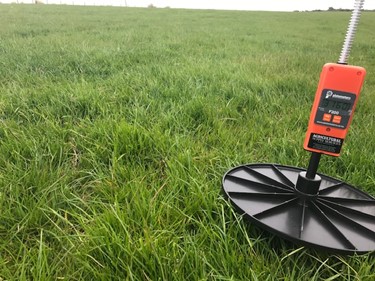Measuring Grass – Is It Worth It?
30 September 2020Is measuring grass necessary for running a beef and sheep farm? No, but if you want to make the most of your resources it certainly helps.
To understand whether stock performance is affected by grass supply, the golf ball height rule works just fine. If grass is lower than golf ball height, then we cannot expect grazing livestock to be performing optimally. For those rotational grazing, we aim for Coke can height or Guinness can height upon field entry for sheep and cattle respectively.
However, if we convert the height into kilograms of dry matter per hectare (kg DM/ha, termed ‘grass cover’) we can now understand the feed quantity in a field, in the same way we can quantify the tonnes of feed in storage, to better understand the feed supply situation.
Benefits
Monitoring the farm average cover through the year is the only gauge of the ‘pasture bank’. You start to see when that bank is starting to drop and this information provides time to make cost-effective decisions. Those that monitored farm average pasture covers (requires at least 50% of the farm measured monthly) during 2018 made the decisions to feed in the winter to preserve spring grass and destocked sooner during the summer drought.
In addition, grass growth information can help with stocking density decisions. For the week commencing 14th September, the GrassCheck GB grass growth average for Scottish sheep and Beef farms was 24.7 kg DM/ha/day. Under set stocking, we estimate that 50% of grass is wasted whereas under rotational grazing the wastage can be reduced to 25%, i.e. at 24.7 kg DM/ha/day grass growth, 12.3 to 18.5 kg DM/ha/day is eaten for set stocked and rotational grazing respectively. Dry ewes in good condition require 2% of their body weight per day – 1.5 kg DM/day for a 75 kg ewe. Therefore, if looking to maintain the average grass height over the grazed area, they can be stocked at 12/ha if rotationally grazed or 8/ha if set stocked.
Measuring grass on your farm is the only way to make these calculations specific to you. The easiest approach to calculate grass growth is to measure grass height when the stock leave a field (using a QMS Sward stick or a pasture plate meter) and again before they re-enter then divide the difference by the number of days rested. Record this on a monthly basis and you build a record of grass growth through the year. With this information you being to learn where the grass growth is deviating from the norm and can adapt the stocking accordingly.
Free sward sticks are available from QMS, but a plate meter will give greater confidence in the figures. Get in touch for free spreadsheets and information on commercial tools that are designed to support these calculations. Funding support to purchase a plate meter is available under the current Sustainable Agriculture Capital Grants Scheme which closes on 11th October.
Poppy Frater, poppy.frater@sac.co.uk
Sign up to the FAS newsletter
Receive updates on news, events and publications from Scotland’s Farm Advisory Service

